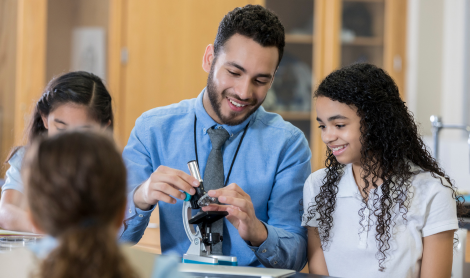This blog post was written by David Greenberg, Director of Leadership Development at NACSA. These are David’s reflections after participating in the new school application process with Osprey Wilds ELC, and do not necessarily reflect the positions of Osprey Wilds ELC, other reviewers participating in the process, or the school proposal teams.
Participating in a new school application review process is one of the most exciting aspects of charter school authorizing.
This is the point where you can really see the vision, dreams, creativity, experience, and skills of school developers. (Or sometimes, not.) It is also a time in which you can learn about the vision, dreams, creativity, experience, and skills of a community. (Or sometimes, not.)
Early in 2021, I had the opportunity to experience all of the above as a member of the new school application review team for Osprey Wilds ELC (OW), the largest authorizer in Minnesota. I had worked at OW (formerly known as the Audubon Center of the North Woods) as the Director of Charter School Authorizing for seven years. Now I was back in an external capacity, as a member of the team that would review the eight applications received by OW from across the state–Minneapolis, the suburbs, the exurbs, and Up North (as we say around here).
While I can’t say I entered this process thinking concretely about community-centered authorizing, the concept was certainly on my mind. We have been talking about it a lot here at NACSA these last months—both how NACSA and authorizers around the country could make our work more community-centered. And there it was in the evaluation rubric, which asked me both directly and indirectly to think about how the proposed charter school planned to center community.
How the Charter School Application Process Can Begin to Center Community
I cannot imagine a stronger group of evaluators: Erin Anderson, Director of Charter School Authorizing at OW, searched out and recruited 20-plus reviewers, both local and national, who were experienced in charter schools and the specific models being proposed (such as Montessori, micro-schools, Indigenous education, multi-lingual programs, etc.). Many were also current or former charter school leaders or board members.
After I met my fellow evaluators at the OW-provided training, aspects of community-centered authorizing became clearer to me. The evaluators were not just there for their professional expertise. They, importantly, reflected and understood the lived experience of students who would be served by these proposed schools, and Erin understood that the majority of her staff and board do not. Nearly three quarters of reviewers identified as Black, Indigenous, Asian-American, Latino, and/or from immigrant backgrounds. Many reviewers were part of the communities where these proposed schools would be located.
We were also guided by a strong set of new school application questions designed to ensure that families and students were indeed interested in the proposed school and that it reflected and would be part of the intended community (not imposed upon or done to the community).
Serving Communities by Listening to Parent and Family Needs
As I reviewed these applications, I saw concrete examples of how school developers centered—or failed to center–the hopes and needs of communities.
One proposed school, STEM Micro School, represented “an evolution of the demand for a safe learning environment for students to get academic support while they were in distance learning during the COVID-19 pandemic.” School founders had piloted a program in Spring 2020, in partnership with the local YMCA, a school currently authorized by OW, and a nonprofit led by one of the founders. This pilot currently serves over 350 students at six learning pods at YMCAs across the Twin Cities area.
These pods serve primarily Black children and other students of color, an overwhelming majority of whom are eligible for free or reduced-price lunch. These pods incorporate virtual instruction by licensed teachers, “academic navigators” on site with students, and a mobile STEM learning lab funded through community partnerships and run by the nonprofit Spark-Y. This pilot program was a direct response to parent and community needs, and the proposed STEM Micro School is in response to the demand for more. Members of the OW staff had the opportunity to visit pilot pods in Fall 2020, seeing the concept come to life even before the new school application was submitted.
In December 2020, founders surveyed the pilot families: 95 percent of respondents indicated, yes, they “would like to go to a school that is a pod like this and has regular STEM activities like on the mobile innovation lab.” Further, nearly 90 percent of parents responding said that their experience with the pods “was better than their child’s previous school experience.” The school developers provided evidence of support from more than 12 local community-based organizations, as well as the President of the Twin Cities YMCA.
This proposed school’s founding group is currently small. But it was clear to all of us who read the application and participated in the capacity interview that the proposed STEM Micro School is responsive to what families and communities need and want. Founders have worked in, and in some cases are part of, the community they hope to serve. The information they provided in the application, the evidence of community support, and the plans for ongoing parent and community participation in the development of the school and the various microsites, was impressive.
All that, coupled with OW staff’s first-hand experience seeing the pilot pods in action, led to a unanimous recommendation for approval by the reviewers. Osprey Wilds’ board of directors agreed, approving this school at their April 2021 board meeting. The school is scheduled to open three sites in Fall 2022 with additional sites to follow in subsequent years.
Community Voice is Crucial in Creating Equitable Schools
Another proposed K-8 school described its mission and approach as “Strengthened by a high-quality education that is equity-minded, socially just, and critically antiracist, graduates […] will be fully prepared for success and leadership in challenging high school programs and beyond.” The school founders, while understanding that charters in Minnesota must be open to all, were inspired by the work of Dr. Monique Morris and designed the school “to meet the academic and social-emotional needs of girls, in particular girls who are Latina, Black, or brown.”
The founding board was an extremely strong group in many ways, and included teachers, school superintendents, local college and university professors of education, and an instructional leader with experience at a successful Minneapolis charter school. They planned to locate the school in the increasingly economically and racially diverse inner-ring suburbs just to the south of Minneapolis.
The application had many strengths, and most concerns were addressed during the capacity interview or through OW’s request for additional information. Founders outlined a compelling educational program grounded in research and experience, ambitious and attainable goals, and a strong governance and management plan. They demonstrated an understanding of the operational side of running a charter school and presented a viable financial plan.
The application and founding team had one glaring problem. They had no evidence of community interest in, or support for, this proposed school. They presented no evidence of community engagement leading up to the submission of the application. Essentially, they did not and could not answer the application questions bulleted above.
The capacity interview shone an even brighter light on this issue. A school designed to meet the needs of Black and Latina girls had no one with that lived experience as part of the founding team. One founder had served as a consultant for a math and reading program in the area; another had experience in a school that serves a demographically similar population on the other side of the city; a third founder lives in one of the target suburbs. Beyond that, the founders had done little to establish meaningful connections to families in this community.
Further, the way the applicant group spoke about “community” raised reviewers’ eyebrows. While they shared that they knew it was important to learn about “the cultural needs of the community,” they had not done that work. And they did not talk about community assets. Instead, they seemed to hold assumptions about the community, some of which could be damaging. One board member said that she felt the board had a lot of experience in this area and could be “pied pipers,” seemingly indicating that the community would follow the school founders, not the other way around.
Reviewers overwhelmingly recommended denial of this application, as it did not meet the standards on all required areas. The school founders withdrew their application and may apply again next year to OW or another authorizer.
I hope the founders recalibrate their approach and utilize the feedback they were given. I hope the founders broaden their team to include the community they wish to serve and allow the school vision to evolve based on the needs and aspirations of the community.
Why Community Voice is Vital in the School Approval Process
In all, five of the eight applications received and reviewed were approved by the OW board of directors and sent on to the Minnesota Department of Education for final approval. The five that were approved, while not perfect nor free of risk—as no charter school application is, demonstrate OW’s commitment to centering communities. These applications, and their founders, communicated the vision, creativity, experience, needs, and aspirations, not only of the founding team, but also of the communities that these schools will be part of, not just located in.
I would argue that the three new school applications that were not approved also demonstrate OW’s commitment to centering community.
Erin and her team are currently working on revisions to the application to better communicate to potential applicants OW’s focus on equity and centering students and community. To ensure multiple voices are included, they will be seeking feedback from the recent cadre of reviewers. I look forward to continue learning from the opportunity.
Read more about how this commitment to collaboration #WithCommunities happens in practice and why it’s critical to advancing quality education systems. To read the full guide for educators, school leaders and advocates, visit WithCommunities.org.
Read another powerful example from David’s reflections on centering community here.


